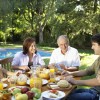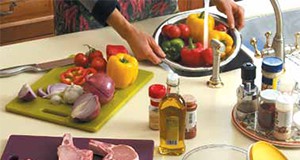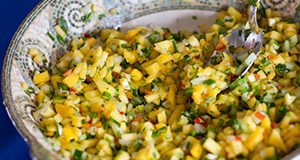For older adults who want to stay healthy, it’s a common question: should I eat three meals a day, or is two adequate? Also, how much should I snack? This 2-page publication discusses the appropriate amount of daily food consumption in older adults. Written by Wendy J. Dahl and Zainab Alyousif and published by the UF/IFAS Department of Food Science and Human Nutrition, August 2018.
http://edis.ifas.ufl.edu/fs313
Tag: Meals and Snacks
Healthy Eating: Meals Without Cooking
This 2-page fact sheet is a major revision featuring a fun word search and a delicious recipe that requires no cooking. Written by Linda B. Bobroff, and published by the UF Department of Family, Youth and Community Sciences, revised July 2016.
http://edis.ifas.ufl.edu/fy1215
Raising Healthy Children: Promoting a Positive Feeding Experience
 All parents have heard “I don’t like that!” or “I’m not hungry!” from their child at some point or another. It’s likely that your child will not like every food that is served, but that doesn’t mean mealtime can’t still be a pleasant experience for the family. Parents may think they have sole responsibility for their child’s food choices, but Ellyn Satter, a registered dietitian who specializes in feeding and eating, advises that young children also have responsibility in the eating process. If feeding your child is stressful, read this fact sheet to learn about the division of responsibility in feeding and how to make meal times more enjoyable for the whole family. This 3-page fact sheet was written by Tiffany N. Stodtko, Karla P. Shelnutt, and Gail P.A. Kauwell, and published by the UF Department of Family Youth and Community Sciences, December 2014.
All parents have heard “I don’t like that!” or “I’m not hungry!” from their child at some point or another. It’s likely that your child will not like every food that is served, but that doesn’t mean mealtime can’t still be a pleasant experience for the family. Parents may think they have sole responsibility for their child’s food choices, but Ellyn Satter, a registered dietitian who specializes in feeding and eating, advises that young children also have responsibility in the eating process. If feeding your child is stressful, read this fact sheet to learn about the division of responsibility in feeding and how to make meal times more enjoyable for the whole family. This 3-page fact sheet was written by Tiffany N. Stodtko, Karla P. Shelnutt, and Gail P.A. Kauwell, and published by the UF Department of Family Youth and Community Sciences, December 2014.
http://edis.ifas.ufl.edu/fy1397
Benefits of Family Meals (FCS2324/FY1362)
 Over the past 30 years obesity among children has increased. One way to help youth make healthy food choices is by creating healthy eating choices and habits at home, starting with family meals. When parents value family dinners, children are likely to view family dinners as important. Family meals can provide important examples to show children what foods are good to eat and how much of the good foods they should eat. This 5-page fact sheet was written by Varnessa McCray, Victor W. Harris, and Martie Gillen, and published by the UF Department of Family Youth and Community Sciences, April 2013.
Over the past 30 years obesity among children has increased. One way to help youth make healthy food choices is by creating healthy eating choices and habits at home, starting with family meals. When parents value family dinners, children are likely to view family dinners as important. Family meals can provide important examples to show children what foods are good to eat and how much of the good foods they should eat. This 5-page fact sheet was written by Varnessa McCray, Victor W. Harris, and Martie Gillen, and published by the UF Department of Family Youth and Community Sciences, April 2013.
http://edis.ifas.ufl.edu/fy1362
Healthy Eating: Cooking for One (FCS80008/FY1302)
 You may think that cooking for one is a difficult task because most recipes are intended to serve four or more people. However, there are things you can do to make cooking for one easy and enjoyable. Inlcudes a table of measurements for reducing recipes. This 2-page fact sheet was written by Emily Minton, and published by the UF Department of Family Youth and Community Sciences, May 2012. http://edis.ifas.ufl.edu/fy1302
You may think that cooking for one is a difficult task because most recipes are intended to serve four or more people. However, there are things you can do to make cooking for one easy and enjoyable. Inlcudes a table of measurements for reducing recipes. This 2-page fact sheet was written by Emily Minton, and published by the UF Department of Family Youth and Community Sciences, May 2012. http://edis.ifas.ufl.edu/fy1302
Alimentación Saludable: Cocinando para uno solo (FCS80008Span/FY1303)
 Podría pensarse que cocinar para uno solo es una tarea difícil ya que la mayoría de recetas están hechas para servir a cuatro o más personas. Sin embargo, hay cosas que puede hacer para que sea más divertido cocinar para uno solo. This 2-page fact sheet was written by Emily Minton, and published by the UF Department of Family Youth and Community Sciences, May 2012.
Podría pensarse que cocinar para uno solo es una tarea difícil ya que la mayoría de recetas están hechas para servir a cuatro o más personas. Sin embargo, hay cosas que puede hacer para que sea más divertido cocinar para uno solo. This 2-page fact sheet was written by Emily Minton, and published by the UF Department of Family Youth and Community Sciences, May 2012.
http://edis.ifas.ufl.edu/fy1303
Healthy Eating: Improving Your Convenience Foods (FCS80013/FY1312)
 Convenience foods offer many benefits, but they generally have a low nutritional quality compared to other foods. You can improve the nutritional quality by adding vegetables, fruit, and/or meat and meat alternatives. This 2-page fact sheet was written by Emily Minton, and published by the UF Department of Family Youth and Community Sciences, May 2012.
Convenience foods offer many benefits, but they generally have a low nutritional quality compared to other foods. You can improve the nutritional quality by adding vegetables, fruit, and/or meat and meat alternatives. This 2-page fact sheet was written by Emily Minton, and published by the UF Department of Family Youth and Community Sciences, May 2012.
http://edis.ifas.ufl.edu/fy1312
Alimentación Saludable: Mejorando sus comidas precocidas (FCS80013Span/FY1313)
 Las comidas precocidas son alimentos que requieren poca preparación. ¡Algunas de estas comidas sólo se calientan y están listas para comérselas en menos de cinco minutos!This 2-page fact sheet was written by Emily Minton, and published by the UF Department of Family Youth and Community Sciences, May 2012.
Las comidas precocidas son alimentos que requieren poca preparación. ¡Algunas de estas comidas sólo se calientan y están listas para comérselas en menos de cinco minutos!This 2-page fact sheet was written by Emily Minton, and published by the UF Department of Family Youth and Community Sciences, May 2012.
http://edis.ifas.ufl.edu/fy1313
Shopping for Health: Guide to Frozen Meals (FSHN1202/FS186)
 Busy schedules, limited cooking space, or a lack of kitchen equipment may limit what you eat at meals. But with the large variety of frozen meals that are now in grocery stores, it’s possible to expand your food options and still eat tasty and healthy meals. The key is to know what to look for when you are shopping. To learn how to choose delicious meals that meet your taste preferences and your health needs, read this 3-page fact sheet written by Sarah A. Glenny and Wendy J. Dahl, and published by the UF Department of Food Science and Human Nutrition, January 2012.
Busy schedules, limited cooking space, or a lack of kitchen equipment may limit what you eat at meals. But with the large variety of frozen meals that are now in grocery stores, it’s possible to expand your food options and still eat tasty and healthy meals. The key is to know what to look for when you are shopping. To learn how to choose delicious meals that meet your taste preferences and your health needs, read this 3-page fact sheet written by Sarah A. Glenny and Wendy J. Dahl, and published by the UF Department of Food Science and Human Nutrition, January 2012.
http://edis.ifas.ufl.edu/fs186
A Guide to Meal Replacements (FCS8998/FY1283)
 Many older Americans have problems eating enough to get the calories and nutrients needed for good health. Multiple factors such as disease, money, physical conditions, and access to food and food preparation areas can affect your nutritional status. Consuming meal replacements is one way to offset the effects of these factors. This 3-page fact sheet will help you decide if meal replacements are right for you. Written by Lauren Headrick and Linda B. Bobroff and published by the UF Department of Family Youth and Community Sciences, March 2012.
Many older Americans have problems eating enough to get the calories and nutrients needed for good health. Multiple factors such as disease, money, physical conditions, and access to food and food preparation areas can affect your nutritional status. Consuming meal replacements is one way to offset the effects of these factors. This 3-page fact sheet will help you decide if meal replacements are right for you. Written by Lauren Headrick and Linda B. Bobroff and published by the UF Department of Family Youth and Community Sciences, March 2012.
http://edis.ifas.ufl.edu/fy1283
January 24th is National Peanut Butter Day!
 Try some of these tasty peanut butter ideas from EDIS publications:
Try some of these tasty peanut butter ideas from EDIS publications:
- Peanut butter is a quick, easy, and popular sandwich choice that’s also healthful (in moderation). Use whole-grain bread, and add sliced banana, fruit preserves, or honey and a thin slice of Muenster, Monterey Jack, or mozzarella cheese to your child’s favorite peanut butter. (Tips for Nutritious School Lunches)
- Stuff celery sticks with peanut butter and top with raisins (Choosing Healthy Snacks Using MyPyramid)
- Instead of peanut butter and jelly, try peanut butter and sliced banana. Add a little honey for a sweeter sandwich. (Healthy Eating: Super Sandwiches)
- Banana & Peanut Butter Spread: Cream ½ cup peanut butter, add ¼ cup hot water or evaporated milk, and blend thoroughly. Add ¾ cup mashed ripe banana, and season with 2 to 3 tablespoons lemon or lime juice. (South Florida Tropicals: Banana)
- Peanut Butter Banana Shake: blend 1 cup low-fat milk, 1 banana (fresh or frozen), 1 tbsp creamy peanut butter, 1 tsp vanilla extract (Healthy Eating for Elders: Drink to Your Health)
Peanuts have been one of the more profitable crops grown in the Coastal Plains of the southeastern U.S. for many years. For publications on peanut production in Florida, see Peanut Production topic page.
Peanuts can also be grown in your home garden: see Producing Peanuts for Home Use.
Alimentación Saludable: Super sándwiches (FCS8699Span/FY712)
 Los sándwiches pueden ser comidas rápidas, nutritivas y fáciles de preparar. ¡A continuación verá unos consejos para crear nuevos sándwiches que podrían ser sus favoritos! This 1-page fact sheet is the spanish Language version of Healthy Eating: Super Sandwiches, written by Jennifer Hillan y Emily Minton and published by the UF Department of Family Youth and Community Sciences, July 2011.
Los sándwiches pueden ser comidas rápidas, nutritivas y fáciles de preparar. ¡A continuación verá unos consejos para crear nuevos sándwiches que podrían ser sus favoritos! This 1-page fact sheet is the spanish Language version of Healthy Eating: Super Sandwiches, written by Jennifer Hillan y Emily Minton and published by the UF Department of Family Youth and Community Sciences, July 2011.
http://edis.ifas.ufl.edu/fy712
Healthy Eating: Super Sandwiches (FCS8699/FY711)
 Sandwiches can make quick, easy, and nutritious meals. And here are some tips to create new sandwich favorites! This 1-page fact sheet was written by Jennifer Hillan and Emily Minton, and published by the UF Department of Family Youth and Community Sciences, July 2011.
Sandwiches can make quick, easy, and nutritious meals. And here are some tips to create new sandwich favorites! This 1-page fact sheet was written by Jennifer Hillan and Emily Minton, and published by the UF Department of Family Youth and Community Sciences, July 2011.
http://edis.ifas.ufl.edu/fy711
FCS2286/FY1054 The Importance of Family Dinners
FCS-2286, a 2-page fact sheet by Jodimae Lyttle and Eboni J. Baugh, takes a close look at some family “dinner dynamics” sharing research demonstrating the benefits that eating together can provide family members. Published by the UF Department of Family Youth and Community Sciences, August 2008.
http://edis.ifas.ufl.edu/FY1054

